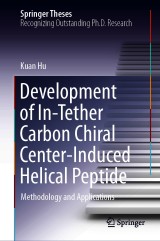Details

Development of In-Tether Carbon Chiral Center-Induced Helical Peptide
Methodology and ApplicationsSpringer Theses
|
171,19 € |
|
| Verlag: | Springer |
| Format: | |
| Veröffentl.: | 26.01.2021 |
| ISBN/EAN: | 9789813366138 |
| Sprache: | englisch |
Dieses eBook enthält ein Wasserzeichen.
Beschreibungen
<p>This book focuses on the development of stapled peptides, a novel molecular modality used to regulate aberrant intracellular protein–protein interactions (PPIs). The author designs and presents a novel helical peptide stabilization methodology by constructing a chiral cross-linker moiety, namely “chiral center induced peptide helicity (CIH)”. The book demonstrates that a precisely positioned carbon chiral center on tether can decisively determine the secondary structure of a peptide, and that the R-configured peptide is helical, while the S-configured peptide is non-helical. Further, it reports that helicity-enhanced R isomer peptides displayed significantly enhanced cell permeability and target binding affinity, as well as tumor inhibition efficiency, in comparison to S isomer peptides. The book will not only advance readers’ understanding of the basic principle of stapled peptides, but also accelerate the clinical transformation of stapled peptide drugs. <br></p>
<p>Introduction.- Method to construct in-tether chiral center constrained helical peptide.- Application in disrupting p53/MDM2 protein-protein interactions.- Fabrication of nanomaterials with in-tether chiral center constrained helical peptide.</p>
<p>This book focuses on the development of stapled peptides, a novel molecular modality used to regulate aberrant intracellular protein–protein interactions (PPIs). The author designs and presents a novel helical peptide stabilization methodology by constructing a chiral cross-linker moiety, namely “chiral center induced peptide helicity (CIH)”. The book demonstrates that a precisely positioned carbon chiral center on tether can decisively determine the secondary structure of a peptide, and that the R-configured peptide is helical, while the S-configured peptide is non-helical. Further, it reports that helicity-enhanced R isomer peptides displayed significantly enhanced cell permeability and target binding affinity, as well as tumor inhibition efficiency, in comparison to S isomer peptides. The book will not only advance readers’ understanding of the basic principle of stapled peptides, but also accelerate the clinical transformation of stapled peptide drugs. <br></p>
Nominated as an outstanding PhD thesis by Peking University Reports on important progress in the study of stabilized peptide drugs Introduces applications in cancer stem cell therapy and self-assembly for novel nanomaterials Includes a diversity-oriented synthesis methodology for constructing stabilized peptides and a clear study of the correlation between peptides’ structure and their biophysical/biochemical properties
Diese Produkte könnten Sie auch interessieren:

Alzheimer's Disease: Cellular and Molecular Aspects of Amyloid beta

von: J. Robin Harris, Falk Fahrenholz

213,99 €















